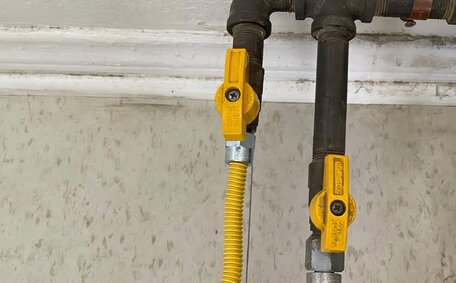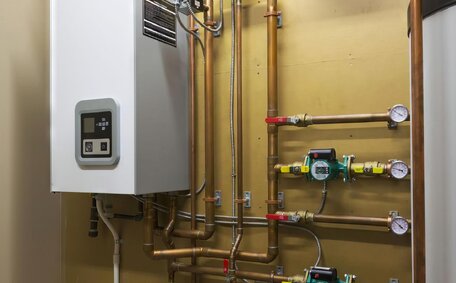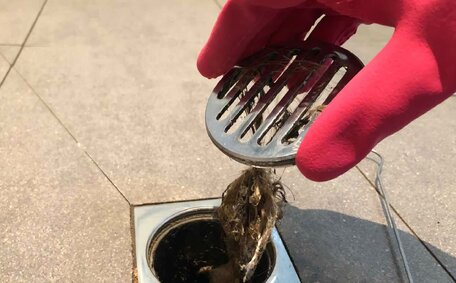Introduction to Pipe Relining: A Faster, Less Invasive Pipeline Repair Method
Drain pipe relining is an innovative trenchless method for repairing a damaged pipe within the plumbing system without the need for full pipe replacement. This process involves inserting a resin-impregnated liner into the existing pipe and curing it in place to form a smooth, seamless new pipe within the old one.
Jannali Plumbing excels in fast and minimally invasive pipe relining for restoring clogged or deteriorated pipes. Pipe relining avoids excavation, minimising disruption and allowing for a swift completion.
Relined pipes enhance flow dynamics and have a longer lifespan than traditional repair methods.
The seamless relining process prevents tree root intrusion and buildup, reducing future blockages.
Typical Pipe Relining Project Duration
A typical pipe relining project takes 1-2 days from start to finish. After an initial inspection and assessment, we will schedule a time that works best for you.
On the day of the project, we start by cleaning and clearing any blockages in the drains. Then our technicians will commence the pipe relining process, installing the materials, which generally takes about 2-4 hours depending on the pipe length and accessibility.
The curing process allows the pipe lining to harden, which can take 4-12 hours. The relined pipes can then be put back into use immediately with full pressure capacity.
Although some jobs may complete within 2 hours, the timeline varies significantly based on pipe complexity, size, material, layout, and site conditions. Multiple access points may also be required for longer pipe runs. We begin with a precise assessment of your pipes to provide an accurate estimate for project duration.
Key Phases of a Pipe Relining Project
A pipe relining project generally involves four main phases:
- Inspection - We thoroughly inspect the pipes using CCTV cameras to identify problem areas and determine the best application method. Measurements are taken to custom-fit the pipe lining material.
- Preparation - High-pressure water jets are used to clean the pipes. Then a protective coating and resin-saturated lining material are inserted into the pipes.
- Relining - The lining material is expanded using heat, air pressure, or UV light to bond with the inner walls of the pipe. The resin cures to a smooth, seamless finish.
- Final Testing - We conduct tests with CCTV cameras, pressure tests, leak tests, and flow tests to make sure the relined pipes are installed correctly and functioning optimally.
The entire process is overseen by our experienced technicians, guaranteeing quality relining services while ensuring minimal property disruption.
CCTV Pipe Inspection and Damage Assessment
Using CCTV or video cameras to inspect pipes prior to relining is a vital step. High-resolution CCTV inspections allow for precise evaluations of internal pipe conditions and issue identification.
Key benefits of CCTV drainage inspections include:
- Accurately locating cracks, breaks, blockages or root ingress
- Identifying optimal access points for pipe relining
- Determining the extent of corrosion or scale build-up
- Measuring pipe diameters to size lining materials
- Documenting pre-existing defects for before/after comparisons
- Ensuring suitability and structural integrity for relining
CCTV inspections furnish essential data to craft the most effective strategy for pipe remediation. The footage provides insights into the extent of damage, informing the feasibility, costs, and preparation for relining that fits the pipe’s specific features.
We manage the disposal of old pipes and conduct post-relining CCTV checks for correct installation and functionality. Contact Jannali Plumbing to discover how pipe relining offers optimised drainage solutions with advanced CCTV technology.
Pipe Cleaning and Preparation
Before any pipe relining work can begin, it’s crucial to consider when the existing pipes have been thoroughly cleaned and prepared. This step is crucial for allowing proper bonding and curing of the relining materials.
We employ high-pressure jetting to clean the interior of pipes. This removes grease, rust, mineral deposits and root intrusions that may be obstructing flow or preventing adhesion. For tenacious blockages, we may resort to mechanical rodding or augering.
After cleaning, CCTV inspections are conducted to verify the pipes are ready for relining. The surfaces must be free of loose debris and structural issues addressed. We may need to temporarily patch small leaks or cracks using epoxy resins before inserting the lining.
Proper pipe preparation gives the new liner material the best conditions to achieve maximum durability.
It also minimises the risk of post-installation failures. Our crew handles all aspects of pre-relining preparation using industry best practises. Contact us today for your pipe assessment and cleaning needs.
Installing and Curing the Pipe Relining
Once the pipes have been thoroughly cleaned and prepared, our technicians are ready to install the pipe relining. First, a protective coating is applied to shield the lining material as it is pulled into place.
The resin-impregnated CIPP (Cured-In-Place Pipe) lining, which is inserted through an access point and expanded using heat, air pressure, or UV light, moulds tightly to the interior walls. Inversion devices and winches facilitate this procedure with minimal impact on surrounding areas.
As the lining material cures and hardens into place over 4-12 hours, the resin forms a tight seal and bonds the lining to the old pipe walls. This produces a smooth, jointless, and corrosion-resistant new pipe within the damaged one, restoring full functionality.
Adhering to best practices, we vigilantly monitor the curing process. Proper heating and dwell times prevents installation flaws and enhances durability. This yields a structurally robust pipeline designed to resist future root intrusion or buildup.
Contact Jannali Plumbing to learn more about our expertise in pipe relining installations and achieving optimal curing results.
Final Testing and Quality Inspection
Once the relining installation is complete, we perform several tests to validate the quality and functionality of the pipes. Our technicians use CCTV cameras for a final visual inspection, checking for proper bonding, smoothness, and any remaining defects or abnormalities.
Additional assessments we perform include:
- Pressure testing - Checks for leaks by applying water pressure inside the pipe at 1.5 times the maximum operating pressure.
- Vacuum testing - Verifies the pipe integrity by pulling negative pressure and measuring any air loss over time.
- Flow testing - Assesses capacity by running water through the system and measuring flow rates in comparison to design parameters.
All our final inspections comply with rigorous industry standards and building codes. We provide certificates upon passing quality assessments, integral to the warranty documentation for the relined pipes.
Contact Jannali Plumbing to learn more about our stringent testing processes that ensure every pipe relining project meets quality and safety benchmarks.
Factors Impacting Project Duration
Several key factors can impact the duration of a pipe relining project:
- Pipe size and length - Larger diameter and longer pipes that need extensive cleaning, preparation, and lining installation take more time.
- Pipe material and age - More corrosion or damage in old, deteriorating pipes increases preparation needed.
- Number of access points - Limited access necessitates additional time for staging equipment.
- Site conditions - Restricted working space or buried pipes require more labour-intensive processes.
- Severity of damage - Extensive repairs like patching leaks or cracks add steps prior to relining.
- Nature of blockages - Difficult obstructions may take longer to clear during cleaning.
Our team conducts comprehensive inspections to incorporate these factors into the project timeline estimate. We’ll discuss expected duration with you upfront based on your system’s specifics. Contact Jannali Plumbing today to learn more.
Pipe Relining Cost Considerations
Relining costs are mostly influenced by the size and length of the pipes undergoing the repair process. Some key considerations include:
- Pipe diameter - Larger pipes require more lining material and take longer to install, increasing costs.
- Total pipe length - Longer piping runs mean higher labour and material expenses.
- Pipe material - Special equipment or lining materials may be needed for certain pipe types like concrete, clay, or cast iron.
- Amount of damage - Severely deteriorated pipes take longer to prepare and reline.
- Site accessibility - Restricted access increases equipment set up and labour costs.
- Location - Emergency repairs in difficult locations can be more expensive.
Typical residential pipe relining costs range from $3,000 to $7,000 depending on these variables. But pipe relining remains far more economical than full pipe replacement, which would otherwise need excavation. It also comes with a long service life, ultimately saving money over time.
Projects for commercial premises or extensive pipelines may incur higher costs.
We provide transparent, customised quotes matching your system’s specifications. Contact us to learn more about the value pipe relining can offer over traditional pipe replacement methods.
The Value of Pipe Relining For Modern Plumbing Systems
Pipe relining offers significant benefits for modern plumbing systems across residential, commercial, and public sectors. As an trenchless alternative to full pipe replacement, it allows ageing or damaged pipes made of materials like concrete, clay, cast iron, and galvanised steel to be restored at a fraction of the cost.
Key benefits of pipe relining include:
- Long lifespan exceeding 50 years with manufacturer warranties up to 10 years
- Prevention of future blockages and root damage
- Significantly less property disruption and landscaping impacts
- Greater environmental friendliness with less waste and emissions
- Suitability for pipes of various dimensions and configurations
- Faster installation measured in hours or days rather than weeks
- Enhanced flow capacity and water pressure
Pipe relining, with its superior durability over traditional methods, modernises plumbing systems and enhances sustainability.
Pipe Relining FAQs
What types of pipe damage can pipe relining repair?
Pipe relining effectively repairs a range of damages like cracks, breaks, blockages and leaks in drain and sewer lines. It works for pipes made of materials like concrete, clay, cast iron, and galvanised steel.
How long does a pipe relining project take?
Generally, pipe relining projects are completed within 1-2 days, accommodating different pipe types. The relining process itself typically takes 2-4 hours, in addition to time for inspection, preparation, curing, and testing.
How long does pipe relining last?
Properly installed pipe lining has a typical lifespan of 50+ years. Many manufacturers provide warranties of up to 10 years on pipe relining projects.
Does pipe relining reduce flow capacity?
No, pipe relining actually increases flow capacity and water pressure by smoothing out pipe interiors. It also prevents future buildup and blockages.
Conclusion and Call-to-Action
As this article has covered, pipe relining provides a minimally invasive, efficient solution for restoring deteriorated or blocked pipes. Without the need for excavation and pipe replacement, relining repairs damage, prevents future blockages, and extends service life at a fraction of the cost and time.
Jannali Plumbing specialises in advanced pipe relining using CIPP technology and state-of-the-art installation methods. Our expert team handles every phase of the process, from inspection to final testing, to deliver long-lasting results.
Acknowledging each situation’s uniqueness, we tailor solutions to your pipeline’s specific requirements. Contact us today for an obligation-free assessment or quote on upgrading your plumbing with modern pipe relining.
Phone: 1300 349 338 Email: [email protected]






